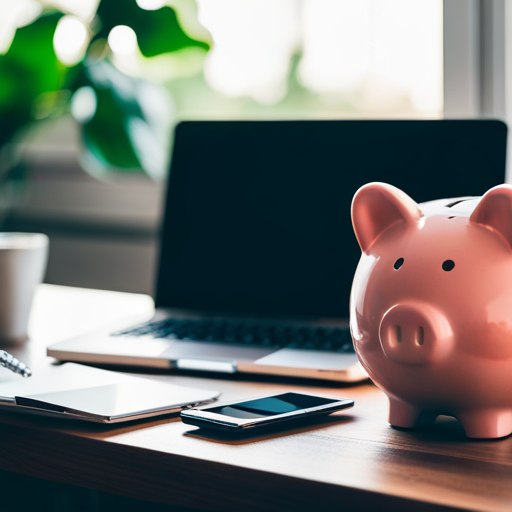To build an emergency fund without feeling the pinch, start by setting clear savings goals and breaking them into manageable milestones. Automate your savings to guarantee consistent contributions. Cut unnecessary expenses like unused subscriptions and dining out too often. Boost your income through freelancing or part-time jobs. Regularly monitor your progress and adjust your strategies as needed. Celebrating small successes along the way can also keep you motivated. By following these tips, you’ll gradually build a robust emergency fund with minimal discomfort, and there are more actionable insights available to help you achieve your goals efficiently.
Key Takeaways
– Automate small, regular transfers to your savings account to build your emergency fund effortlessly.
– Set clear, achievable savings goals and break them into smaller, manageable milestones.
– Cut unnecessary expenses, such as unused subscriptions, to free up funds for savings.
– Increase your income by freelancing, taking a part-time job, or selling unused items.
– Regularly review and adjust your savings strategy to stay on track and celebrate progress.
Set Clear Savings Goals
Setting clear savings goals helps individuals stay motivated and track their progress when building an emergency fund. By defining specific targets, people can transform abstract financial aspirations into concrete objectives. This clarity encourages disciplined saving, reducing the temptation to dip into funds for non-essential expenses.
To set effective savings goals, individuals should start by determining the total amount needed for their emergency fund. A common recommendation is to save three to six months’ worth of living expenses. This provides a safety net in case of unexpected events, such as job loss or medical emergencies.
Next, breaking down the total savings target into smaller, manageable milestones can make the process feel less overwhelming. For instance, if someone needs $9,000, they might aim to save $3,000 every three months. This approach offers periodic opportunities to celebrate progress, reinforcing a sense of achievement and belonging within a community of like-minded savers.
Additionally, setting a timeline for achieving these goals instills urgency and focus. A well-defined timeframe transforms the savings process from a vague intention into a structured plan.
Ultimately, clear savings goals empower individuals to build their emergency funds with confidence and purpose, fostering financial stability and community solidarity.
Automate Your Savings
After establishing clear savings goals, automating your savings can streamline the process and guarantee consistent contributions to your emergency fund. Setting up automatic transfers from your checking account to a dedicated savings account assures that saving becomes a routine part of managing finances. By doing this, individuals eliminate the need to remember to save, reducing the temptation to spend extra funds instead.
Automating savings can be easily managed through online banking platforms. Most banks offer options to schedule regular transfers, whether weekly, bi-weekly, or monthly. This method allows for flexibility, enabling adjustments as financial situations change. It’s important to select a frequency that aligns with income patterns to avoid disrupting other financial obligations.
Another benefit of automation is the psychological aspect. When savings are automated, individuals are less likely to miss the money being transferred. It’s a form of ‘paying yourself first,’ a principle that promotes financial discipline. Over time, these regular contributions accumulate, building a substantial emergency fund without the stress of manual saving.
In essence, automating savings transforms a potentially tedious task into a seamless part of financial management, fostering a sense of security and community among those committed to financial well-being.
Cut Unnecessary Expenses
Identifying and eliminating unnecessary expenses is an essential step in maximizing the amount of money that can be directed into an emergency fund. By scrutinizing monthly expenditures, individuals can uncover areas where they might be overspending. For instance, subscription services often go unnoticed and can add up over time. Canceling unused memberships or downgrading to a more affordable plan can free up funds immediately.
Another effective strategy involves reviewing utility bills. Simple adjustments like turning off lights when they aren’t in use or lowering the thermostat slightly can result in significant savings. Additionally, meal planning and cooking at home more frequently can reduce dining-out expenses, which are often higher than grocery costs.
Entertainment expenses also warrant examination. Instead of costly movie outings or concert tickets, exploring free or low-cost community events can provide enjoyable alternatives without the hefty price tag.
It’s equally important to avoid impulsive purchases. Waiting 24 hours before buying non-essential items can help determine if they’re truly necessary.
Boost Your Income
One effective way to accelerate the growth of an emergency fund is to explore opportunities to boost your income. By supplementing primary earnings, individuals can expedite their savings without feeling the financial strain.
Freelancing offers numerous avenues to earn extra cash. Skills such as writing, graphic design, or programming can be monetized through platforms like Upwork or Fiverr. These gig economies provide flexible work schedules, making them suitable for busy professionals.
Part-time jobs are another viable option. Retail, hospitality, or remote customer service roles can provide steady, additional income. These positions often require minimal training and can be tailored around existing commitments.
Selling unused items is another straightforward method. Platforms like eBay or Facebook Marketplace enable individuals to declutter while generating funds. Items such as electronics, clothing, and furniture often fetch reasonable prices.
Furthermore, participating in the sharing economy can be lucrative. Renting out a spare room on Airbnb or driving for ride-sharing services like Uber can create substantial earnings.
Each strategy requires effort, but the reward is a more robust emergency fund. By proactively seeking additional income sources, individuals can strengthen their financial resilience and foster a sense of security within their community.
Monitor and Adjust
Regularly reviewing and adjusting savings strategies helps to make sure that the emergency fund stays aligned with changing financial goals and circumstances. Life is dynamic, and what worked six months ago mightn’t be effective today. By setting a monthly or quarterly check-in, individuals can track their progress and make necessary adjustments.
Monitoring involves examining current savings, evaluating spending habits, and identifying any new expenses or income sources. This regular review allows individuals to spot potential shortfalls early and take corrective action. For instance, if expenses have increased due to a life event, they may need to temporarily increase their savings rate to maintain their emergency fund’s health.
Adjusting the savings strategy doesn’t mean making drastic changes. Small tweaks, like cutting back on non-essential spending or automating additional transfers to the emergency fund, can make a significant impact over time.
It’s also important to celebrate milestones, as recognizing progress fosters a sense of accomplishment and encourages continued diligence.
Frequently Asked Questions
How Much Money Should an Emergency Fund Ideally Have?
An ideal emergency fund should sufficiently cover three to six months’ worth of living expenses. This range guarantees financial stability during unforeseen circumstances, providing peace of mind and a sense of security within the community.
Can I Use My Emergency Fund for Non-Emergency Expenses?
No, they shouldn’t use their emergency fund for non-emergency expenses. Doing so could leave them financially vulnerable during genuine emergencies, undermining the fund’s purpose and their financial security. It’s essential to maintain discipline with these savings.
What Types of Accounts Are Best for Emergency Savings?
For emergency savings, he should consider high-yield savings accounts, money market accounts, or certificates of deposit. These options offer security and liquidity, ensuring funds are easily accessible when needed without sacrificing growth potential.
How Do I Stay Motivated to Save for an Emergency Fund?
Staying motivated to save for an emergency fund involves setting clear goals, celebrating small milestones, and joining a supportive community. Regularly tracking progress and visualizing financial security can also inspire continued commitment to building savings.
Can I Use Financial Apps to Help Manage My Emergency Fund?
Yes, you can use financial apps to manage your emergency fund. They offer features like automated savings, expense tracking, and goal setting, making it easier to stay organized and motivated alongside a community of like-minded savers.
Conclusion
Building an emergency fund doesn’t have to be intimidating. By setting clear savings goals, automating contributions, cutting unnecessary expenses, boosting income, and monitoring progress, anyone can steadily grow their financial safety net.
These strategies, when combined, make the process manageable and less overwhelming. Over time, the small adjustments will add up, ensuring financial security without significant hardship.
It’s all about consistent, mindful actions that lead to a more secure future.



